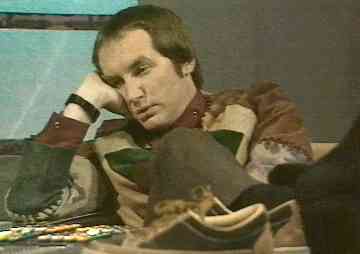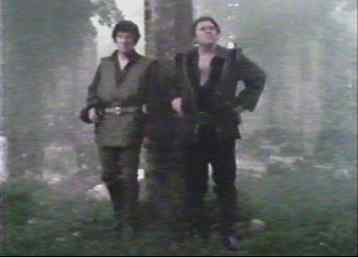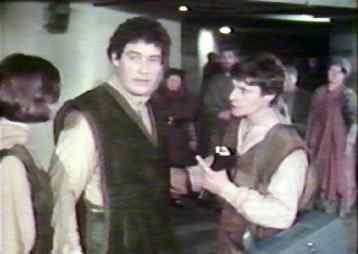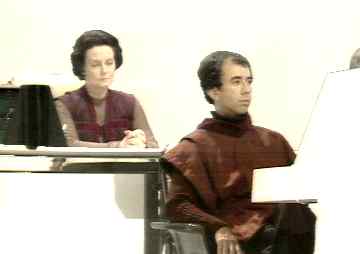
Vila in Duel
A timepiece originally designed to be accurate in all conditions of a ship's motion, temperature, pressure, and gravity, allowing accurate timekeeping - and therefore accurate navigation - to take place at sea. The first properly accurate Earth chronometers were designed and made by the British clockmaker John Harrison (1693-1776).
In the Blake's 7 universe, it was used to refer to a timepiece worn around the wrist, known to many inhabitants of late twentieth century Earth as a 'wristwatch'. In 'Gold', Keiller advised the passangers of the Space Princess to 'please tune all chronometers to frequency seven for syncronization with Federation Standard Time'.
Chronometers were worn by 17 of the characters in the series - most notably in the first season - in the following episodes:
| The Way Back | Blake, Maja, Varon, and Ravella |
| Space Fall | Blake, Avon, Laylan, and Raiker |
| Cygnus Alpha | Blake, Avon, and Leylan |
| Time Squad | Blake, Avon, and Vila |
| The Web | Blake, Avon, and Vila |
| Seek-Locate-Destroy | Blake, Avon, and Vila |
| Mission to Destiny | Blake, Avon, and Vila |
| Duel | Blake, Avon, and Vila |
| Project Avalon | Avon |
| Breakdown | Blake, Avon, and Vila |
| Bounty | Blake |
| Deliverance | Blake |
| Orac | Blake, Avon, and Ensor |
| Trial | Jenna |
| Hostage | Ushton |
| Countdown | Provine and Tronos |
| Star One | Jenna |
| Powerplay | Tarrant |
| Rumours of Death | Anna Grant |
| Animals | Ardus |
| Headhunter | Technician 241 |
|
In total, chronometers were worn in 21 epsiodes, Space Fall being the one
when the largest number of chronometers were worn (4). Blake wore a
chronometer the most times during the series, in a total of 12 episodes,
followed by Avon in 10 and by Vila in 6. Avon and Vila wore their
chronometers on their right wrists; all the other characters wore theirs on
their left. Two characters wore different types of chronometers in
different episodes: Blake wore a different chronometer from his usual one
in 'Orac', while Jenna wore different chronometers in each of the two
episodes she was seen wearing one.
|  Vila in Duel |
Other chronometers shown were, in late twentieth-century terms, more conventional looking. Blake, in 'Orac', wore a chronometer that, while black, had a round face with hands. Overall, external chronometer design in the Blake's 7 universe appeared to be quite achronistic, relying on late twentieth-century wristwatch models.
Also of interest was the lax attitude of the Federation authorities to the wearing of chronometers by prisoners, despite the security risks. Blake's chronometer was taken from him before his trial in 'The Way Back', but restored to him after he was sentenced; he was later seen using it to co-ordinate the attempted takeover of the London in 'Space Fall'. From what was seen in 'Hostage', Ushton was also presumably allowed to bring his chronometer with him to Exbar.
| Vargas ruled from a building strongly reminiscent of a church in Cygnus Alpha: it was used for religious purposes. Vila's description of it was "The architectural style is early Maniac". The inhabitants of Mecron II worshipped in a cave used for church-like purposes in Games. The only "real" church was the ruined one on Earth in Pressure Point, in the vaults of which Veron trapped Blake, Avon, Vila and Gan. It was the pre-appointed rendezvous for Blake's meeting with Kasabi's rebels, and Blake had to tell Gan what the building was and what it had been used for. |  The ruins in Pressure Point |
A portrait of Churchill is visible in Sarkoff's collection.
|
Used by Dal Richie to bypass the security monitors on doorway Sub-43 of the
dome city on Earth. Varon appears to have used a similar device when he
later left the city, but his exit was detected.
|  In Richie's hand |
Very few urban locations were visited by the crew. Blake was originally seen to live in an enclosed dome city on Earth (sources outside the series refer to "West Europ Dome" - no mention of this was made in the episode as broadcast). Space City was an artificial space environment, run by the Terra Nostra. Fen referred to a city on UP-Clonemaster, much of it alive and made of a mood-responsive vegetable life form. The conference centre on Atlay was presumably within a city. Freedom City was located on an unnamed planet. Keldon City was struck by the neutron drive unit of the destroyed Nova Queen. There was at least one city on Auron. At least some of the events in Death-Watch probably took place within a city. The magnetrix terminal on Helotrix was within an unnamed city, and some large pyramidal buildings were discernible in the background on occasion. In Warlord, Avon presented a videocast of pacified citizens on the planet Zondawl, this film having been taken in a distinctly urban environment.
Translated name of the city-like structure on Keezarn to which Vila was taken to open the vault door for Bayban. Vila deduced that the structure was not a city at all but a "travel terminus". It was destroyed by Bayban's use of a laser cannon in attempting to reopen the door.
Practor was noted by the General on Helotrix as having been on the Federation's Civil List for years, and his loyalty was beyond question. The Civil List may have been a catalogue of reliable individuals who could be entrusted to handle affairs for the Federation on their home worlds. Alternatively, it may refer to a noble or equivalent class native to Helotrix.
The description of a Federation award for bravery, which possibly originated from a mention in an official Federation dispatch. Travis told Veron in _Pressure Point_ that she might receive the award because she trapped Blake and most of his crew in a building without their teleport bracelets, suggesting that it was at least conferred on civilians who risked their lives to prevent crime.
No further details were given of the award in terms of where it stood in any Federation order of precedence, or if its recipients were allowed to wear any emblem or ribbon.
|
An official seemingly responsible for compiling and keeping court records,
a function unchanged since the late twentieth century AD. The clerk of the
court that tried and sentenced Blake in The Way Back was referred to as
such, but only in the episode's closing credits. Travis's court martial in
Trial had an unmentioned and uncredited official, seated opposite Major
Thania, who appeared to perform the function of a clerk.
|  Arbiter (left) Clerk of Court (right) |